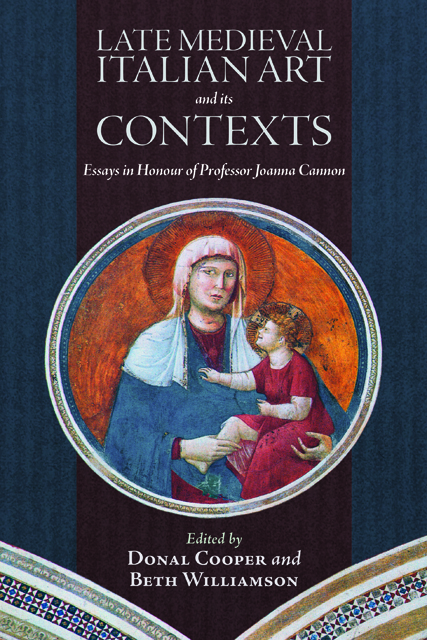Book contents
- Frontmatter
- Contents
- List of Illustrations
- List of Contributors
- Acknowledgements
- List of Abbreviations
- 1 Introduction: Circling Giotto
- 2 Holy Wood / ‘sacra tavola’: Saint Dominic and the Memory of Miracles in Bologna
- 3 The Sculpted Saint: A Statue of Saint Francis in Siena
- 4 Guccio di Mannaia and the Concept of a ‘Franciscan’ Chalice
- 5 ‘Speculum sine macula’: The Trittico di Santa Chiara in Trieste as an Object of Clarissan Devotion
- 6 The Siena Connection: A Franciscan Provincial Minister between Tuscany and Assisi at the Dawn of the Trecento
- 7 Simone Martini’s ‘Treaty with the House of Santa Fiora’ in Siena’s Palazzo Pubblico: Its Date and Significance
- 8 Crisis and Charity in Fourteenth-Century Florence: Ambrogio Lorenzetti’s Saint Nicholas Panels for San Procolo
- 9 Father of Light: Giotto and the Beatific Vision in the Baroncelli Chapel
- 10 Painter-Illuminator Workshops and the Church of San Giorgio a Ruballa: The Case of Bernardo Daddi and Pacino di Bonaguida
- 11 Patterns of Holiness: A Virgin Lactans in a Franciscan Context
- 12 A New Angle on Simone Martini’s Holy Family
- 13 Artistic Appropriation, Institutional Identity, and Civic Religion in Fourteenth-Century Siena: The Byzantine Treasury of the Hospital of Santa Maria della Scala
- 14 Visual Religious Education in Late Medieval Florence: Zanobi Perini, The Leggenda di Santo Tobia, and The Misericordia
- 15 Saints and Status in Late Medieval and Early Renaissance Florence
- Select Bibliography
- Publications by Joanna Cannon
- Index
- Tabula Gratulatoria
- Backmatter
3 - The Sculpted Saint: A Statue of Saint Francis in Siena
Published online by Cambridge University Press: 20 December 2022
- Frontmatter
- Contents
- List of Illustrations
- List of Contributors
- Acknowledgements
- List of Abbreviations
- 1 Introduction: Circling Giotto
- 2 Holy Wood / ‘sacra tavola’: Saint Dominic and the Memory of Miracles in Bologna
- 3 The Sculpted Saint: A Statue of Saint Francis in Siena
- 4 Guccio di Mannaia and the Concept of a ‘Franciscan’ Chalice
- 5 ‘Speculum sine macula’: The Trittico di Santa Chiara in Trieste as an Object of Clarissan Devotion
- 6 The Siena Connection: A Franciscan Provincial Minister between Tuscany and Assisi at the Dawn of the Trecento
- 7 Simone Martini’s ‘Treaty with the House of Santa Fiora’ in Siena’s Palazzo Pubblico: Its Date and Significance
- 8 Crisis and Charity in Fourteenth-Century Florence: Ambrogio Lorenzetti’s Saint Nicholas Panels for San Procolo
- 9 Father of Light: Giotto and the Beatific Vision in the Baroncelli Chapel
- 10 Painter-Illuminator Workshops and the Church of San Giorgio a Ruballa: The Case of Bernardo Daddi and Pacino di Bonaguida
- 11 Patterns of Holiness: A Virgin Lactans in a Franciscan Context
- 12 A New Angle on Simone Martini’s Holy Family
- 13 Artistic Appropriation, Institutional Identity, and Civic Religion in Fourteenth-Century Siena: The Byzantine Treasury of the Hospital of Santa Maria della Scala
- 14 Visual Religious Education in Late Medieval Florence: Zanobi Perini, The Leggenda di Santo Tobia, and The Misericordia
- 15 Saints and Status in Late Medieval and Early Renaissance Florence
- Select Bibliography
- Publications by Joanna Cannon
- Index
- Tabula Gratulatoria
- Backmatter
Summary
Sculpture is not a medium generally associated with early Franciscan art. Joanna Cannon has shown how the Dominicans used sculpted imagery on their founder’s tomb as part of a strategy to promote his cult in the second half of the thirteenth century. The Friars Minor, on the other hand, spread the visual image of their founder almost exclusively through frescoes and panel paintings; and some of the earliest sculpted representations of Saint Francis are not in Franciscan churches but on cathedral facades in France and Spain, among the elect in Last Judgement scenes. Any reader of Franciscan texts, though, must be struck by their vivid and frequent use of sculptural imagery to portray the founder of the Order and his most distinctive attributes, the stigmata. Saint Francis’s body was imagined as having been melted and imprinted like wax, moulded like clay, hammered like metal or chiselled like stone. Saint Francis is described by his most important thirteenth-century biographer, Bonaventure of Bagnoregio, as coming down from the mountain of La Verna, after his transformative vision of the Christ-Seraph, ‘bearing with him the likeness of the Crucified, depicted not on tablets of stone or on panels of wood carved by hand, but engraved on parts of his flesh by the finger of the living God’. In his final years ‘he was squared like a stone to be fitted into the construction of the heavenly Jerusalem, and like a work of malleable metal he was brought to perfection by the hammer of many tribulations’. These are metaphors, to be sure, drawing on a longstanding tradition of comparing saints to ‘living statues’, and freighted with biblical allusions intended to reveal the eschatological significance of Saint Francis’s life. But it was central to the Order’s purpose that they should be understood not just as figures of speech but as describing a corporeal reality. Francis had been physically changed on La Verna: the side wound and the nails had quite literally been carved and modelled in his flesh to transform him into an image of the crucified Christ.
- Type
- Chapter
- Information
- Late Medieval Italian Art and its ContextsEssays in Honour of Professor Joanna Cannon, pp. 33 - 50Publisher: Boydell & BrewerPrint publication year: 2022



